Cho phương trình : 3cosx + cos2x - cos3x + 1 = 2sinx.sin2x . Gọi \(\alpha\) là nghiệm lớn nhất thuộc khoảng ( 0;2\(\pi\) ) của phương trình . Tính \(sin\left(\alpha-\frac{\pi}{4}\right)\) .
Hãy nhập câu hỏi của bạn vào đây, nếu là tài khoản VIP, bạn sẽ được ưu tiên trả lời.


1.
\(cos2x-3cosx+2=0\)
\(\Leftrightarrow2cos^2x-3cosx+1=0\)
\(\Leftrightarrow\left[{}\begin{matrix}cosx=1\\cosx=\dfrac{1}{2}\end{matrix}\right.\)
\(\Leftrightarrow\left[{}\begin{matrix}x=k2\pi\\x=\pm\dfrac{\pi}{3}+k2\pi\end{matrix}\right.\)
\(x=k2\pi\in\left[\dfrac{\pi}{4};\dfrac{7\pi}{4}\right]\Rightarrow\) không có nghiệm x thuộc đoạn
\(x=\pm\dfrac{\pi}{3}+k2\pi\in\left[\dfrac{\pi}{4};\dfrac{7\pi}{4}\right]\Rightarrow x_1=\dfrac{\pi}{3};x_2=\dfrac{5\pi}{3}\)
\(\Rightarrow P=x_1.x_2=\dfrac{5\pi^2}{9}\)
2.
\(pt\Leftrightarrow\left(cos3x-m+2\right)\left(2cos3x-1\right)=0\)
\(\Leftrightarrow\left[{}\begin{matrix}cos3x=\dfrac{1}{2}\left(1\right)\\cos3x=m-2\left(2\right)\end{matrix}\right.\)
\(\left(1\right)\Leftrightarrow x=\pm\dfrac{\pi}{9}+\dfrac{k2\pi}{3}\)
Ta có: \(x=\pm\dfrac{\pi}{9}+\dfrac{k2\pi}{3}\in\left(-\dfrac{\pi}{6};\dfrac{\pi}{3}\right)\Rightarrow x=\pm\dfrac{\pi}{9}\)
Yêu cầu bài toán thỏa mãn khi \(\left(2\right)\) có nghiệm duy nhất thuộc \(\left(-\dfrac{\pi}{6};\dfrac{\pi}{3}\right)\)
\(\Leftrightarrow\left[{}\begin{matrix}m-2=0\\m-2=1\\m-2=-1\end{matrix}\right.\Leftrightarrow\left[{}\begin{matrix}m=2\\m=3\\m=1\end{matrix}\right.\)
TH1: \(m=2\)
\(\left(2\right)\Leftrightarrow cos3x=0\Leftrightarrow x=\dfrac{\pi}{6}+\dfrac{k2\pi}{3}\in\left(-\dfrac{\pi}{6};\dfrac{\pi}{3}\right)\Rightarrow x=\dfrac{\pi}{6}\left(tm\right)\)
\(\Rightarrow m=2\) thỏa mãn yêu cầu bài toán
TH2: \(m=3\)
\(\left(2\right)\Leftrightarrow cos3x=0\Leftrightarrow x=\dfrac{k2\pi}{3}\in\left(-\dfrac{\pi}{6};\dfrac{\pi}{3}\right)\Rightarrow x=0\left(tm\right)\)
\(\Rightarrow m=3\) thỏa mãn yêu cầu bài toán
TH3: \(m=1\)
\(\left(2\right)\Leftrightarrow cos3x=-1\Leftrightarrow x=\dfrac{\pi}{3}+\dfrac{k2\pi}{3}\in\left(-\dfrac{\pi}{6};\dfrac{\pi}{3}\right)\Rightarrow\left[{}\begin{matrix}x=\pm\dfrac{1}{3}\\x=-1\\x=-\dfrac{5}{3}\end{matrix}\right.\)
\(\Rightarrow m=2\) không thỏa mãn yêu cầu bài toán
Vậy \(m=2;m=3\)

Chọn D
Phương trình tương với:
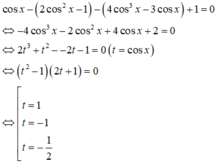
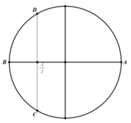
Trên đường tròn đơn vị, các điểm nghiệm của phương trình là 4 điểm A, B, C, D như hình vẽ. Do đó trên nửa khoảng [ - π ; 0 ) , phương trình có đúng 2 nghiệm (là - π và - 2 π 3 ).

Đáp án D.
Phương trình tương với:
cos x − 2 cos 2 x − 1 − 4 cos 3 x − 3 cos x + 1 = 0 ⇔ − 4 cos 3 x − 2 cos 2 x + 4 cos x + 2 = 0 ⇔ 2 t 3 + t 2 − − 2 t − 1 = 0 t = cos x ⇔ t 2 − 1 2 t + 1 = 0 ⇔ t = 1 t = − 1 t = − 1 2
Trên đường tròn đơn vị, các điểm nghiệm của phương trình là 4 điểm A, B, C, D như hình vẽ. Do đó trên nửa khoảng − π ; 0 , phương trình có đúng 2 nghiệm (là − π và − 2 π 3 ).
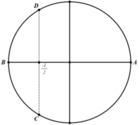

Đáp án B
Ta có: P T ⇔ 4 c os 3 x − 3 cos x + 2 sin 2 x + 9 sin x − 5 = 0
⇔ cos x 4 c os 2 x − 3 + 2 sin 2 x + 9 sin x − 5 = 0 ⇔ cos x 1 − 4 sin 2 x + 2 sin x − 1 s inx + 5 = 0 ⇔ 2 sin x − 1 cos x + 2 sin x cos x + s inx + 5 = 0 ⇔ 2 sin x − 1 s inx + cos x + sin 2 x + 5 = 0 ⇔ 2 sin x − 1 = 0 ⇔ s inx = 1 2 ⇔ x = π 6 k 2 π x = 5 π 6 + k 2 π
Với x ∈ 0 ; 3 π ⇒ x = π 6 ; 5 π 6 ; π 6 + 2 π ; 5 π 6 + 2 π ⇒ T = 6 π .
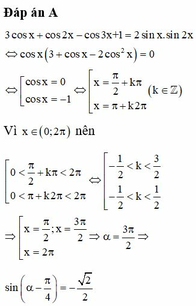
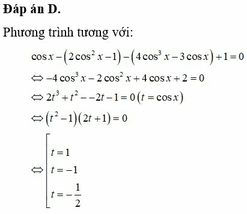
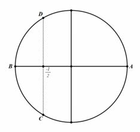
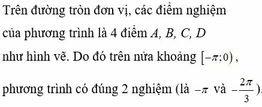
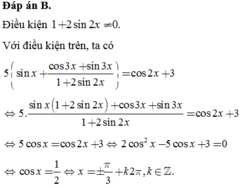
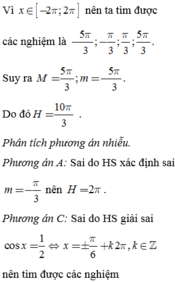
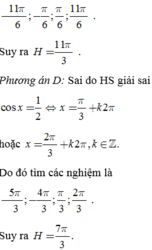
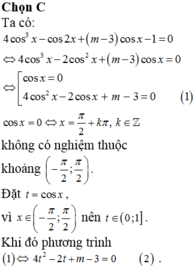
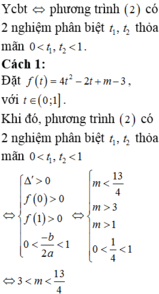
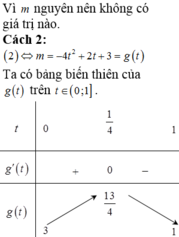

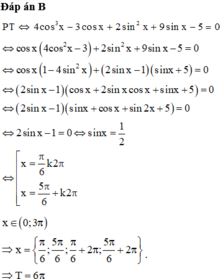
\(3cosx+2cos^2x-1-\left(4cos^3x-3cosx\right)+1=4cosx.sin^2x\)
\(\Leftrightarrow6cosx+2cos^2x-4cos^3x=4cosx\left(1-cos^2x\right)\)
\(\Leftrightarrow3cosx+cos^2x-2cos^3x=2cosx-2cos^3x\)
\(\Leftrightarrow cos^2x+cosx=0\)
\(\Leftrightarrow\left[{}\begin{matrix}cosx=0\\cosx=-1\end{matrix}\right.\)
\(\Leftrightarrow\left[{}\begin{matrix}x=\frac{\pi}{2}+k\pi\\x=\pi+k2\pi\end{matrix}\right.\)
\(\Rightarrow\) Nghiệm lớn nhất trên \(\left(0;2\pi\right)\) là \(\alpha=\frac{3\pi}{2}\)
\(sin\left(\frac{3\pi}{2}-\frac{\pi}{4}\right)=-\frac{\sqrt{2}}{2}\)